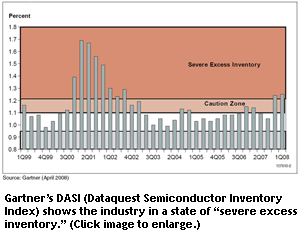據Gartner咨詢公司稱:半導體庫存現狀比想象的要糟糕
Gartner公司報道稱電子類供應鏈中半導體存貨現狀要比早期給出的警示指標更糟。
該公司在三月份給出的預測說:從2007年第四季度起在電子供應鏈中過剩的庫存將繼續影響2008年第二季度的半導體行業。Gartner的此項聲明是在其DASI(半導體庫存指數)基礎之上給出的,從該數據看,庫存量在2007第四季度時明顯攀升,低迷的半導體庫存量從2007年第三季度的1.04增漲到1.16,需要降低對2008第一季度的銷售估測。
Gartner公司說,DASI是通過電子供應鏈比較行業目前的水平來評定標準庫存水平,并對行業趨勢做出預測。該指數測定是在每個生產階段都測試正常的庫存,實現產品平穩的循環和生產過程的管理,不再出在庫存短缺或過剩情況。
Gartner分析家Gerald Van Hoy在半導體DQ星期一報道中說:“我們正在研究2007年第四季度的結果,其可以從實際的角度顯示DASI數據,從實際狀況折射DASI顯示的庫存,并從實際上指示嚴重的過剩庫存信息(1.20或是更高),在1.22到1.25之間。”
Van Hoy說修訂此版本的原因是DASI是一個預言性的,利用一致數據,來測定下一季度的收入趨勢的指數數據。因為Gartner正在監控庫存天數,從COGS(主營業務成本)中的值為進行估算,實際的數字能夠影響上一季度的最終結果。此外,Gartner利用公司的邊際利潤率來決定他們的COGS,隨后利潤率被用來決定庫存天數。
Van Hoy說:“2007第四季度庫存量為什么會這么嚴格是因為在我們的模塊中擁有精確的COGS數值。 同時,我們看到2008年第一季度的估測半不是很完善。"
Gartner在三月建議半導體公司應當持平或是降低庫存。市場研究公司報道英特爾的庫存相對比較多。根據Gartner統計,英特爾從2006年第四季度的89.4降低到了2007年第四季度的67.9。Gartner在Xilinx, Pixelworks, Mindspeed Technologies, Qimonda, Benchmark Electronics, and Celestica發布了類似的庫存下降報道。

Gartner說:“在inventory daysm的這些負面的結果中,依據Gartner的數據,非常引人注目的是英飛淩,比率幾乎雙倍化,從2007年第三季的66.3增至下一季度的121.4。此外,其它公司的庫存天數——賽普拉斯半導體、Spansion、德州儀器和Monolithic Power Systems都在增漲。”
Van Hoy說:“在許多供應鏈中都發現了庫存天數的增長,但是此種情況對半導體銷售商、OEM和電子零售商尤為嚴重。”
要剎住庫存上漲,似乎要與供應鏈一邊的半導體提供商有關,尤其是內存、無線通信、消費類和在多種市場上的多設備供應商有關。
Gartner公司稱,影響下降的因素從三月份聲明發布后就一直沒有改變。它們是市場條件延遲反應最直接的原因,比預期的第四季度要疲軟。傳統上第一季度比較疲軟,據整體經濟狀況反映,不得不對金融界有些擔心。但是現在數字正在增長,這些擔心不僅屬正常,而且可能比預測的更糟。
Van Hoy寫到:在重返正常庫存水平之前,這種過剩的庫存也許會在現在引起另兩個季度的庫存過剩, 半導體供應鏈處于一個很微弱的位置,并且對未來的整體經濟活動很敏感。進入2008年,企業們需要減少庫存,此將能通過大范圍的減量生產或價格調整實現庫存降低。
Van Hoy說,Gartner公司預測到DASI保留在第一季度的嚴重過剩的庫存狀況,有可能持續到第二季度。我們看到2008第一季度已達到頂峰,DASI開始在2008第二季度開始下降。
[FONT=times]
original text [/FONT]
[font=times] Semiconductor inventory situation worse than thought: Gartner [/font]
[font=times][Color=#708090]An increase in inventory days has been seen in most of the supply chain, but it is particularly severe for semiconductor vendors, communications OEMs, and electronics retailers, according to the market research company.
By Suzanne Deffree, Managing Editor, News
The electronics supply chain‘s semiconductor-inventory situation is worse off than earlier warnings indicated, Gartner Inc reported this morning.
The market research company in March forecasted that excess inventory in the electronics supply chain from a poor Q4 2007 could continue to impact the semiconductor industry through Q2. Gartner made that statement based on the performance of its Dataquest Semiconductor Inventory Index (DASI), which spiked significantly in Q4, to 1.16 from 1.04 in Q3 2007 on lackluster semiconductor "holiday sales" and lowered expectations for sales in Q1.
The DASI assesses normal inventory levels throughout the electronics supply chain and compares them with current levels to evaluate industry trends, Gartner explained. The index gauges the normal inventory level at each stage of production that will allow for a smooth flow of products and management of the production process without inventory shortages or surpluses, the company said.
"We now project that the fourth quarter of 2007 results will actually tilt the DASI higher for this period and will in fact indicate a severe excess inventory event (meaning 1.20 or higher), coming in between 1.22 and 1.25," Gartner analyst Gerald Van Hoy wrote in today‘s Semiconductor DQ Monday Report.
Van Hoy said the reason for the revision is that the DASI is predictive and uses consensus data for the next quarter‘s revenue outlook. Because Gartner is monitoring days of inventory, which is calculated from the cost of goods sold (COGS), actual numbers can affect the final result for a previous quarter. Furthermore, Gartner uses companies‘ profit margin ratios to determine their COGS; then the ratios are used to determine inventory days, Van Hoy wrote.
"The severity of the fourth quarter of 2007 spike is because we now have actual COGS numbers to enter into our model, and we see that the estimates for the first quarter of 2008 were not severe enough," Van Hoy stated. "Declining sales expectations and the associated decline in COGS resulted in the spike we are now observing."
Gartner in March advised semiconductor companies to level or drop inventories. The market-research company today credited Intel for posting positive numbers with regard to inventory days. Intel dropped its inventory days from one of its highest points of 89.4 in Q4 2006 to 67.9 in Q4 2007, according to Gartner. Gartner noted similar declines in inventory days at Xilinx, Pixelworks, Mindspeed Technologies, Qimonda, Benchmark Electronics, and Celestica.
Among those posting negative results in inventory daysm according to Gartner‘s data, the most dramatic was Infineon, which nearly doubled its ratio, from 66.3 in Q3 2007 to 121.4 in the following quarter. Further, inventory days at other companies—Cypress Semiconductor, Spansion, Texas Instruments, and Monolithic Power Systems—have been steadily on the rise, Gartner said.
"The increase in inventory days has been seen in most of the supply chain, but it is particularly severe for semiconductor vendors, communications OEMs, and electronics retailers," Van Hoy said.
"The failure to put the brakes on inventory appears to be a supply-side issue with certain semiconductor-device suppliers; this is particularly true for memory, wireless communications, consumer, and diversified suppliers that compete in several device markets," he continued.
Gartner said that the reasons for the spike in the DASI (see below) have not changed since its March statements. "They are the direct result of a delayed reaction to market conditions; a weaker-than-expected fourth quarter; a traditionally weak first quarter; and worries from the financial community regarding macroeconomic conditions and warnings. But now the numbers are coming in, and those worries are not only valid, they are worse than expected," Gartner‘s report stated.
"This surplus in inventory may now take another two quarters before returning to normal ranges," Van Hoy wrote. "The semiconductor supply chain is in a delicate position and vulnerable to a future macroeconomic event. Moving deeper into 2008, companies will need to drop their inventories. This might be achieved by more aggressive measures to reduce obsolete inventory or by making pricing adjustments."
Gartner said it expects the DASI to remain in the "severe excess inventory" state in Q1 and possibly Q2. "We see the first quarter of 2008 as the crest, with the DASI beginning to trend down in the second quarter of 2008," Van Hoy said.[/color][/font]
聲明:本文為中國傳動網獨家稿件,轉載請務必注明出處。















![]()
![]()
![]()
![]()





















 網站客服
網站客服 粵公網安備 44030402000946號
粵公網安備 44030402000946號